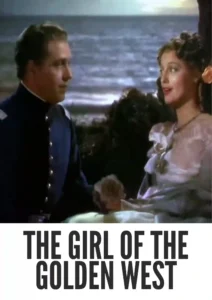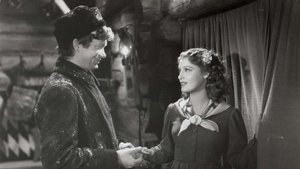Video Sources 0 Views
- The Girl of the Golden West 1938 Colorized


Synopsis
Table of Contents
ToggleSaloon Singer, Bandit, and Love: The Girl of the Golden West (1938) in Vivid Color

Step into the romantic Old West with The Girl of the Golden West, a musical western romance from 1938, now beautifully colorized for a captivating viewing experience. This film, directed by Robert Z. Leonard, delivers a heartwarming blend of music, romance, and western adventure within the setting of a lively saloon. Perfect for fans of classic musicals and those seeking a taste of Hollywood’s golden age, this HD download brings a beloved cinematic treasure to your screen. This movie is also known as Die Goldene Westen.
The Girl of the Golden West Storyline: A Love Story in the Wild West
The Girl of the Golden West tells the story of Mary Robbins (Jeanette MacDonald), a spirited saloon owner who falls in love with a mysterious bandit named Ramirez (Nelson Eddy). Mary, nicknamed “The Girl,” runs the Polka Dot Saloon, a popular spot for miners and outlaws alike.As Mary and Ramirez’s love blossoms, they must navigate the dangers of the Wild West, including a relentless sheriff determined to capture Ramirez and bring him to justice. Their relationship is tested by secrets, betrayals, and the constant threat of violence. The film culminates in a dramatic showdown, where Mary must risk everything to save the man she loves. Ultimately, The Girl of the Golden West is a sweeping romance filled with memorable musical numbers and stunning western landscapes.
Movie Cast
The film features a talented cast of actors who bring this romantic story to life:
- Jeanette MacDonald as Mary Robbins
- Nelson Eddy as Ramirez
- Walter Pidgeon as Jack Rance
- Leo Carrillo as Jake
- Dick Kirby as Joe
Movie Genre
The Girl of the Golden West falls into the genre of musical western romance, combining elements of classic Hollywood musicals with the adventure and drama of the Wild West. Its memorable songs, romantic storyline, and vibrant setting make it a captivating and entertaining film.
Historical Context: Hollywood’s Golden Age
Released in 1938, The Girl of the Golden West represents a highlight of Hollywood’s golden age, showcasing the popularity of musical westerns and the star power of Jeanette MacDonald and Nelson Eddy. The film was produced during a period when Hollywood studios were producing lavish musicals that combined romance, adventure, and spectacle. While The Girl of the Golden West is one of many classic musicals from this era, it remains a beloved example of the genre, known for its memorable songs and charming performances.
Colorization Details
This colorized version of The Girl of the Golden West has been meticulously restored using modern digital techniques, enhancing the visual appeal while preserving the film’s original charm and romance. The colorization process involved carefully analyzing the grayscale tones of the original black and white footage and assigning appropriate colors to each scene. While the specific software used remains proprietary, the techniques employed included advanced algorithms for color palette selection and image enhancement. This painstaking process brings new life to the characters and settings, making the story even more engaging for modern audiences. While some may debate the merits of colorizing classic films, it introduces these films to a broader audience, ensuring their legacy for future generations.
Technical Details
- Director: Robert Z. Leonard
- Screenplay: Isabel Dawn, Boyce De Gaw, based on the play by David Belasco
- Cinematography: Oliver T. Marsh
- Edited by: W. Donn Hayes
- Production Company: Metro-Goldwyn-Mayer (MGM)
- Distributed by: Metro-Goldwyn-Mayer (MGM)
- Runtime: 120 minutes
Technical Specifications
- Download Format: MP4
- Resolution: HD (1080p)
- Compatibility: Compatible with most devices, including smartphones, tablets, computers, and smart TVs.
Reviews and Critical Reception
The Girl of the Golden West (1938) is celebrated for its memorable musical numbers, romantic storyline, and the charming performances of Jeanette MacDonald and Nelson Eddy. As a classic example of the musical western genre, it remains a beloved film for fans of Hollywood’s golden age. As a relatively popular and entertaining film, The Girl of the Golden West provides a delightful escape into a world of music, romance, and western adventure.
FAQs
- Q: What is The Girl of the Golden West about?
- A: The Girl of the Golden West is a musical western romance about a saloon owner who falls in love with a mysterious bandit.
- Q: Is The Girl of the Golden West (1938) a well-known musical?
- A: The Girl of the Golden West is a classic example of the musical western genre, known for its memorable songs and charming performances.
- Q: Is this version of The Girl of the Golden West colorized?
- A: Yes, this version has been professionally colorized to enhance the viewing experience.
- Q: What makes The Girl of the Golden West interesting for classic film fans?
- A: The Girl of the Golden West offers a delightful escape into a world of music, romance, and western adventure, showcasing the star power of Jeanette MacDonald and Nelson Eddy.
- Q: What is the download format?
- A: The download format is MP4, which is compatible with most devices.
- Q: What resolution is the download?
- A: The resolution is HD (1080p), providing a high-quality viewing experience.
Download Now in HD!
Watch The Girl of the Golden West Today!


















